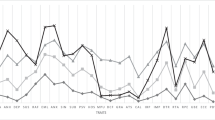Abstract
The relationship between specific defense styles and symptom-related responses was investigated in a large sample of university students. In general, immature defenses were the major predictors of the symptom patterns measured by the Brief Symptom Inventory. In particular, combinations of projection, displacement, autistic fantasy, somatization, and acting out were the strongest predictors of psychopathology. Projection was a major predictor of psychopathology in males, whereas displacement was the major predictor for females. Several similarities and differences in the relationship between defense styles and different disorders were revealed.;or timing of both psychological and hormonal responses to 2 given volumes of training.
Similar content being viewed by others
REFERENCES
Akkerman, K., Lewin, T., & Carr, V. (1999). Long-term changes among patients recovering from major depression. Journal of Nervous and Mental Disease, 187, 80–87.
American Psychiatric Association. (1994). Diagnostic and statistical manual of mental disorders(4th ed.). Washington, DC: Author.
Andrews, G., Pollock, C., & Stewart, G. (1989). The determination of defense style by questionnaire. Archives of General Psychiatry, 46, 455–460.
Andrews, G., Singh, M., & Bond, M. (1993). The Defense Style Questionnaire. Journal of Nervous and Mental Disease, 18, 246–256.
Bond, M. (1986). Defense Style Questionnaire. In G. E. Valliant (Ed.), Empirical studies of ego mechanisms of defense. Washington, DC: American Psychiatric Press, Inc.
Bond, M., Gardner, S., Christian, J., & Sigal, J. (1983). An empirical study of self-rated defense styles. Archives of General Psychiatry, 40, 333–338.
Boulet, J., & Boss, M. W. (1991). Reliability and validity of the Brief Symptom Inventory. Psychological Assessment, 3, 433–437.
Derogatis, L. R., & Spencer, P. M. (1982). The Brief Symptom Inventory (BSI) administration, scoring & procedures manual-I. Baltimore: Johns Hopkins University School of Medicine.
Feldman, S. S., Araujo, K. B., & Steiner, H. (1996). Defense mechansims in adolescents as a function of age, sex, and health status. Journal of the American Academy of Child and Adolescent Psychiatry, 35, 1344–1358.
Johnson, J. G., Bornstein, R. F., & Krukonis, A. B. (1992). Defense styles as predictors of personality disorder symptomatology. Journal of Personality Disorders, 6, 408–416.
Kilmartin, C. T. (1994). The masculine self. London: Macmillan.
Kneepkens, R. G., & Oakley, L. D. (1996). Rapid improvement in the defense style of depressed women and men. Journal of Nervous and Mental Disease, 184, 358–361.
Lobel, T. E., & Winch, G. L. (1986). Different defense mechanisms among men with different sex role orientations. Sex Roles, 15, 215–220.
Maltby, J., & Day, L. (1999). Sex role identity, attitudes toward the opposite sex and same sex, and defense style. Journal of Genetic Psychology, 160, 381–383.
Parker, J. D., Taylor, G. J., & Bagby, R. M. (1998). Alexithymia: Relationship with ego defense and coping styles, Comprehensive Psychiatry, 39, 91–98.
Perry, J. C., Hoglend, P., Shear, K., Valliant, G. E., Horowitz, M., Kardos, M. E., Bille, H., & Kagan, D. (1998). Field trial of a diagnostic axis for defense mechanisms for DSM-IV. Journal of Personality Disorders, 12, Spring, 56–68.
Pollock, C., & Andrews, G. (1989). Defense styles associated with specific anxiety disorders. American Journal of Psychiatry, 146, 1500–1502.
Sammallahti, P., Aalberg, V., & Pentinsaari, J-P. (1994). Does defense style vary with severity of mental disorder? An empirical assessment. Acta Psychiatrica Scandinavica, 90, 290–294.
Spinhoven, P., & Kooiman, C. G. (1997). Defensive style in depressed and anxious psychiatric outpatients: an explorative study. Journal of Nervous and Mental Disease, 185, 87–94.
Vaillant, G. E. (1971).Theoretical heirarchy of adaptive ego mechanism: A 30 year follow-up of 30 men selected for psychological health. Archives of General Psychiatry, 24, 107–118.
Vaillant, G. E. (1977). Adaptation to life. Boston: Little and Brown & Company.
Vaillant, G. E. (1994). Ego mechanisms of defense and personality psychopathology. Journal of Abnormal Psychology, 103, 44–50.
Vingerhoets, A., & Van Heck, G. (1990). Gender, coping and psychosomatic symptoms. Psychological Medicine, 20, 125–135.
Watson, D. C., & Sinha, B. K. (1998). Gender, age and cultural differences in the defense style questionaire-40. Journal of Clinical Psychology, 54, 67–75.
Watson, D. C., & Sinha, B. K. (1999). A cross-cultural comparison of the Brief Symptom Inventory. International Journal of Stress Management, 6, 255–264.
Author information
Authors and Affiliations
Rights and permissions
About this article
Cite this article
Watson, D.C. Predicting Psychiatric Symptomatology with the Defense Style Questionnaire-40. International Journal of Stress Management 9, 275–287 (2002). https://doi.org/10.1023/A:1019930332257
Issue Date:
DOI: https://doi.org/10.1023/A:1019930332257



